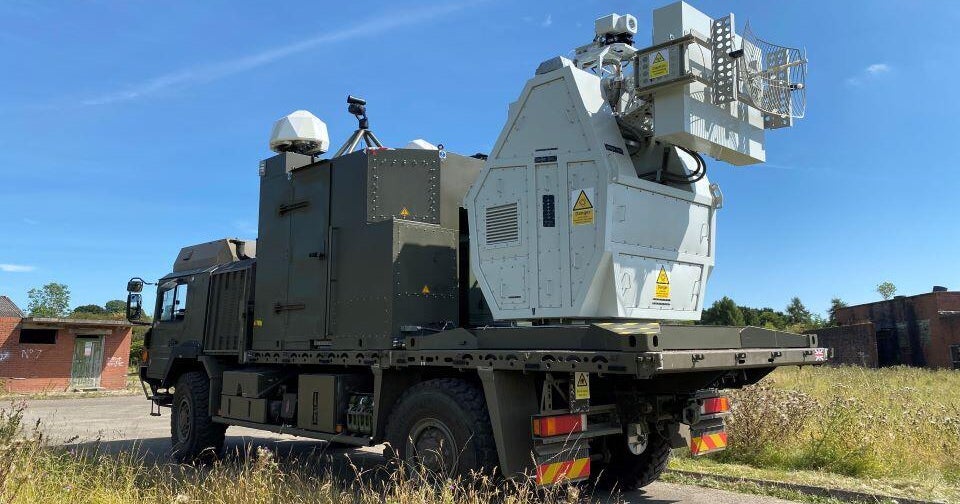In a significant advancement for U.K. military technology, the British Army successfully tested a new radio frequency directed energy weapon (RF DEW) capable of neutralizing drone swarms. This groundbreaking exercise, which marks a major milestone in counter-drone efforts, took place at a military range in Wales. The innovative “RapidDestroyer” system is designed to offer a cost-effective defense solution against coordinated drone attacks, amidst growing concerns about the use of drones in modern warfare.
| Article Subheadings |
|---|
| 1) Overview of the RapidDestroyer System |
| 2) The Significance of the Test |
| 3) Cost-Effectiveness and Defense Strategy |
| 4) Context of Drone Warfare |
| 5) Future Implications of RF DEW Technologies |
Overview of the RapidDestroyer System
The RapidDestroyer is a new radio frequency directed energy weapon developed by a consortium spearheaded by the British division of the French defense contractor Thales. During the recent field tests, British soldiers effectively tracked, targeted, and downed swarms of drones. This was accomplished at a military range in Wales and marks the largest counter-drone swarm exercise undertaken by the British Army thus far.
Incorporating advanced technology, the RF DEW operates by emitting radio wave energy, which can disrupt or damage the components of drones. This is a revolutionary approach as it allows for direct targeting, unlike traditional methods that generally focus on interrupting communication channels between the drone and its operator.
The Significance of the Test
This recent trial is not merely a technological demonstration. With the increasing sophistication of drone warfare, the ability to neutralize multiple drones simultaneously is crucial for national defense. The U.K. government emphasized that during the test, the RapidDestroyer intercepted over 100 drones, showcasing its effectiveness in real-time scenarios.
The trial also highlighted the current range limitations of the weapon, which is optimally effective at distances of up to half a mile. However, the government is actively working on improvements to extend this range, thereby enhancing its operational capability against aerial threats that may evade traditional defense mechanisms.
Cost-Effectiveness and Defense Strategy
Cost efficiency is a crucial aspect of the RapidDestroyer’s design, with each shot estimated to cost around $0.18. This represents a significant reduction in expenditure when compared to conventional missile systems, making it an attractive option for defense budgets. The British government believes that RF DEWs can serve as a viable supplement to traditional air defense measures.
The U.K. Ministry of Defense has pledged that RF DEW systems will play a significant role in upcoming national defense spending plans as part of a broader strategy to employ innovative technologies. Starting from the fiscal period of 2025-26, at least 10% of the Ministry of Defense’s equipment procurement budget is earmarked for novel defense technologies.
Context of Drone Warfare
The motivation behind advancing this technology can be traced to the increasing use of drones in global conflicts, particularly highlighted by Russia’s extensive use of drones in its confrontation with Ukraine. The U.K. government pointed out that last year alone, Ukraine faced attacks from over 18,000 drones, underlining the necessity for enhanced drone defense capabilities.
Experts, including those from the Royal United Services Institute, have noted that high-powered microwave systems like the RF DEW could serve as effective deterrents not only against small drones but also against larger threats such as cruise missiles. As global security dynamics evolve, the role of advanced technologies in military strategies becomes ever more critical.
Future Implications of RF DEW Technologies
The successful test of the RapidDestroyer raises questions about the future landscape of drone warfare and countermeasures. Its effectiveness in intercepting drone swarms could lead to a paradigm shift in military engagement strategies. As discussions about military spending intensify, particularly following the latest budget announcements, the focus on such innovative approaches will likely escalate.
With growing investments in advanced weaponry, the U.K. government aims to fortify its stance against aerial threats to vital areas such as defense installations and airports. The implementation of RF DEW technologies opens up possibilities for creating secure airspace in sensitive regions, potentially reshaping how air defenses are strategized in the modern era.
| No. | Key Points |
|---|---|
| 1 | U.K. military successfully tested a new RF DEW known as RapidDestroyer. |
| 2 | The system can effectively intercept drone swarms, having taken down over 100 drones in tests. |
| 3 | Each shot from the weapon costs approximately $0.18, making it cost-effective compared to missile systems. |
| 4 | Acknowledges the growing threat of drone warfare, especially evidenced in the conflict involving Ukraine. |
| 5 | The U.K. is allocating more resources toward innovative military technologies in its upcoming budgets. |
Summary
The recent testing of the RapidDestroyer by the U.K. military not only marks a pivotal moment in counter-drone technology but also emphasizes the evolving landscape of modern warfare. As nations adapt to aerial threats, the development and deployment of such advanced systems are crucial for future defense strategies. The initiative reflects a broader commitment to investing in innovative technologies that can secure national interests and safeguard sensitive areas from drone-related disruptions.
Frequently Asked Questions
Question: What is the RapidDestroyer?
The RapidDestroyer is a Radiofrequency Directed Energy Weapon developed to neutralize drone swarms effectively.
Question: How does the RF DEW work?
The RF DEW operates by emitting radio wave energy to directly disrupt or damage drone components, rather than just jamming their signals.
Question: Why is there an increasing focus on drone defense technologies?
The focus on drone defense is driven by the growing use of drones in warfare, particularly highlighted by their use in conflicts, such as the war in Ukraine, where extensive drone attacks have been observed.


